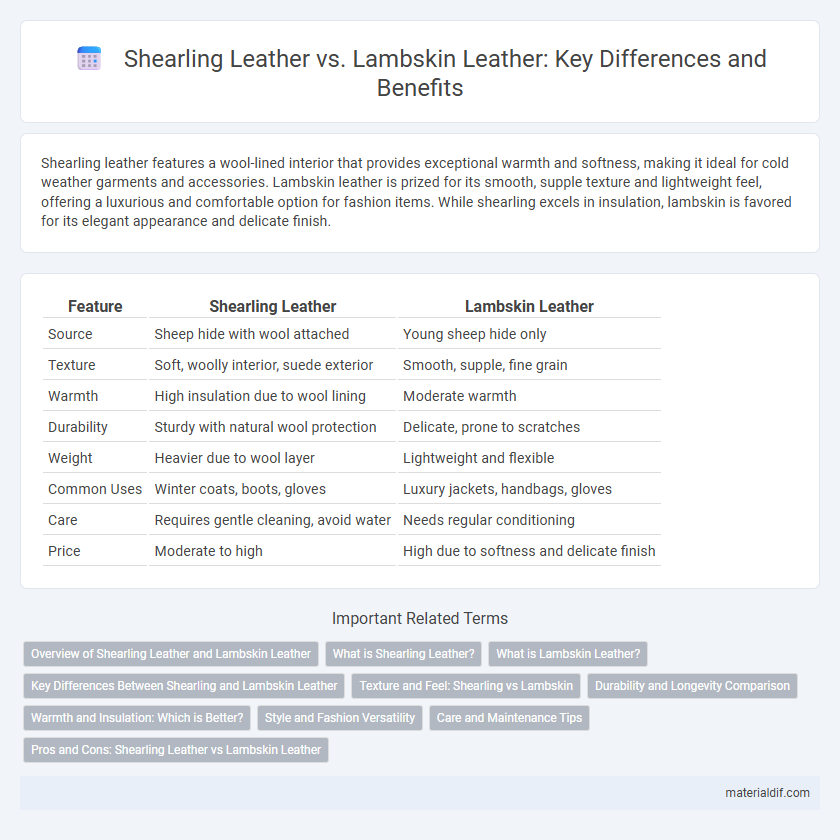Shearling leather features a wool-lined interior that provides exceptional warmth and softness, making it ideal for cold weather garments and accessories. Lambskin leather is prized for its smooth, supple texture and lightweight feel, offering a luxurious and comfortable option for fashion items. While shearling excels in insulation, lambskin is favored for its elegant appearance and delicate finish.
Table of Comparison
| Feature | Shearling Leather | Lambskin Leather |
|---|---|---|
| Source | Sheep hide with wool attached | Young sheep hide only |
| Texture | Soft, woolly interior, suede exterior | Smooth, supple, fine grain |
| Warmth | High insulation due to wool lining | Moderate warmth |
| Durability | Sturdy with natural wool protection | Delicate, prone to scratches |
| Weight | Heavier due to wool layer | Lightweight and flexible |
| Common Uses | Winter coats, boots, gloves | Luxury jackets, handbags, gloves |
| Care | Requires gentle cleaning, avoid water | Needs regular conditioning |
| Price | Moderate to high | High due to softness and delicate finish |
Overview of Shearling Leather and Lambskin Leather
Shearling leather is crafted from sheepskin with the wool still attached, offering exceptional warmth and a soft, fluffy texture ideal for cold weather garments. Lambskin leather, made from the hides of young sheep, is prized for its smooth, supple feel and delicate grain, making it popular in fashion for its lightweight and luxurious finish. Both materials provide unique tactile experiences and durability, with shearling excelling in insulation and lambskin favored for its refined appearance and softness.
What is Shearling Leather?
Shearling leather is crafted from sheepskin with the wool still attached, providing a soft, insulating layer that is both warm and breathable. Unlike lambskin leather, which is made solely from the hide without wool, shearling retains its natural fleece, making it ideal for cold-weather apparel and accessories. This unique combination of leather and wool fibers offers durability, comfort, and superior thermal properties.
What is Lambskin Leather?
Lambskin leather is derived from the hide of young sheep, known for its exceptionally soft and supple texture. This type of leather is highly prized in fashion for its smooth surface, lightweight feel, and natural elasticity. Compared to shearling leather, lambskin lacks the wool lining and offers a sleek, delicate finish ideal for luxury garments and accessories.
Key Differences Between Shearling and Lambskin Leather
Shearling leather is crafted from sheepskin with the wool still attached, providing a plush, insulated texture ideal for warmth, while lambskin leather originates from the hide of young sheep and offers a smooth, supple finish prized for its softness and lightweight feel. The primary difference lies in shearling's double-sided nature--leather on one side and fleece on the other--versus lambskin's uniformly smooth leather surface. Shearling is commonly used in winter apparel for insulation, whereas lambskin is favored in fashion for its elegant drape and delicate appearance.
Texture and Feel: Shearling vs Lambskin
Shearling leather features a soft wool fleece on one side and a suede surface on the other, offering a plush, warm texture with a cozy feel ideal for insulation. Lambskin leather is extremely smooth and supple, characterized by its lightweight softness and fine grain that provides a luxurious, silky touch. The distinct texture of shearling emphasizes warmth and comfort, while lambskin prioritizes sleekness and delicate softness in leather garments.
Durability and Longevity Comparison
Shearling leather, derived from sheepskin with the wool intact, offers superior durability and resistance to wear compared to lambskin leather, which is softer but more susceptible to scratches and stretching. The dense wool fibers in shearling provide added insulation and protection, enhancing its longevity even in harsh conditions. Lambskin leather, prized for its smooth texture and supple feel, requires more delicate care to maintain its appearance and lifespan.
Warmth and Insulation: Which is Better?
Shearling leather, with its natural wool fleece intact, provides superior warmth and insulation compared to lambskin leather, which is smooth and lacks the dense wool lining. The thick shearling wool traps heat effectively, making it ideal for colder climates and outdoor use. Lambskin leather offers a softer texture and more flexibility but falls short in retaining heat, making it less suitable for extreme cold.
Style and Fashion Versatility
Shearling leather offers a cozy, textured look with its soft wool lining exposed, making it a popular choice for stylish outerwear that combines warmth and rustic charm. Lambskin leather is renowned for its smooth, supple surface and sleek appearance, often favored in high-fashion items like jackets and handbags for a polished, elegant finish. Both materials provide distinct fashion versatility, with shearling suited for casual, rugged aesthetics and lambskin excelling in refined, sophisticated wardrobe staples.
Care and Maintenance Tips
Shearling leather requires regular brushing with a soft-bristle brush to maintain its fluffy texture and prevent matting, while lambskin leather benefits from gentle cleaning with a damp cloth and applying a leather conditioner to preserve its smooth, supple finish. Both types should be kept away from direct heat and moisture to avoid cracking or drying out. Storing shearling in a breathable garment bag and lambskin in a cool, dry place helps prolong their lifespan and maintain their premium quality.
Pros and Cons: Shearling Leather vs Lambskin Leather
Shearling leather offers superior warmth and durability due to its dual-layer structure with wool fleece intact, making it ideal for cold weather but tends to be bulkier and requires more maintenance. Lambskin leather is prized for its softness, smooth texture, and lightweight feel, providing exceptional comfort and style, though it is less durable and more prone to scratches and wear over time. Choosing between shearling and lambskin leather depends on the need for insulation and toughness versus softness and elegance in leather garments or accessories.
Shearling Leather vs Lambskin Leather Infographic

 materialdif.com
materialdif.com